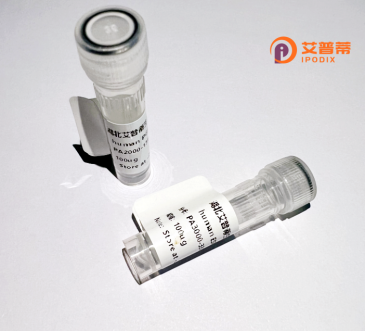
| 纯度 | >90%SDS-PAGE. |
| 种属 | Human |
| 靶点 | BAI2 |
| Uniprot No | O60241 |
| 内毒素 | < 0.01EU/μg |
| 表达宿主 | E.coli |
| 表达区间 | 1-1585aa |
| 氨基酸序列 | MENTGWMGKGHRMTPACPLLLSVILSLRLATAFDPAPSACSALASGVLYGAFSLQDLFPTIASGCSWTLENPDPTKYSLYLRFNRQEQVCAHFAPRLLPLDHYLVNFTCLRPSPEEAVAQAESEVGRPEEEEAEAAAGLELCSGSGPFTFLHFDKNFVQLCLSAEPSEAPRLLAPAALAFRFVEVLLINNNNSSQFTCGVLCRWSEECGRAAGRACGFAQPGCSCPGEAGAGSTTTTSPGPPAAHTLSNALVPGGPAPPAEADLHSGSSNDLFTTEMRYGEEPEEEPKVKTQWPRSADEPGLYMAQTGDPAAEEWSPWSVCSLTCGQGLQVRTRSCVSSPYGTLCSGPLRETRPCNNSATCPVHGVWEEWGSWSLCSRSCGRGSRSRMRTCVPPQHGGKACEGPELQTKLCSMAACPVEGQWLEWGPWGPCSTSCANGTQQRSRKCSVAGPAWATCTGALTDTRECSNLECPATDSKWGPWNAWSLCSKTCDTGWQRRFRMCQATGTQGYPCEGTGEEVKPCSEKRCPAFHEMCRDEYVMLMTWKKAAAGEIIYNKCPPNASGSASRRCLLSAQGVAYWGLPSFARCISHEYRYLYLSLREHLAKGQRMLAGEGMSQVVRSLQELLARRTYYSGDLLFSVDILRNVTDTFKRATYVPSADDVQRFFQVVSFMVDAENKEKWDDAQQVSPGSVHLLRVVEDFIHLVGDALKAFQSSLIVTDNLVISIQREPVSAVSSDITFPMRGRRGMKDWVRHSEDRLFLPKEVLSLSSPGKPATSGAAGSPGRGRGPGTVPPGPGHSHQRLLPADPDESSYFVIGAVLYRTLGLILPPPRPPLAVTSRVMTVTVRPPTQPPAEPLITVELSYIINGTTDPHCASWDYSRADASSGDWDTENCQTLETQAAHTRCQCQHLSTFAVLAQPPKDLTLELAGSPSVPLVIGCAVSCMALLTLLAIYAAFWRFIKSERSIILLNFCLSILASNILILVGQSRVLSKGVCTMTAAFLHFFFLSSFCWVLTEAWQSYLAVIGRMRTRLVRKRFLCLGWGLPALVVAVSVGFTRTKGYGTSSYCWLSLEGGLLYAFVGPAAVIVLVNMLIGIIVFNKLMARDGISDKSKKQRAGSERCPWASLLLPCSACGAVPSPLLSSASARNAMASLWSSCVVLPLLALTWMSAVLAMTDRRSVLFQALFAVFNSAQGFVITAVHCFLRREVQDVVKCQMGVCRADESEDSPDSCKNGQLQILSDFEKDVDLACQTVLFKEVNTCNPSTITGTLSRLSLDEDEEPKSCLVGPEGSLSFSPLPGNILVPMAASPGLGEPPPPQEANPVYMCGEGGLRQLDLTWLRPTEPGSEGDYMVLPRRTLSLQPGGGGGGGEDAPRARPEGTPRRAAKTVAHTEGYPSFLSVDHSGLGLGPAYGSLQNPYGMTFQPPPPTPSARQVPEPGERSRTMPRTVPGSTMKMGSLERKKLRYSDLDFEKVMHTRKRHSELYHELNQKFHTFDRYRSQSTAKREKRWSVSSGGAAERSVCTDKPSPGERPSLSQHRRHQSWSTFKSMTLGSLPPKPRERLTLHRAAAWEPTEPPDGDFQTEV |
| 分子量 | 172 kDa |
| 蛋白标签 | His tag N-Terminus |
| 缓冲液 | 冻干粉 |
| 稳定性 & 储存条件 | Lyophilized protein should be stored at ≤ -20°C, stable for one year after receipt. Reconstituted protein solution can be stored at 2-8°C for 2-7 days. Aliquots of reconstituted samples are stable at ≤ -20°C for 3 months. |
| 复溶 | Always centrifuge tubes before opening.Do not mix by vortex or pipetting. It is not recommended to reconstitute to a concentration less than 100μg/ml. Dissolve the lyophilized protein in distilled water. Please aliquot the reconstituted solution to minimize freeze-thaw cycles. |
以下是关于重组人脑特异性血管生成抑制剂2(BAI2)的参考文献概览:
1. **《BAI2 regulates spatial learning and synaptic plasticity in the hippocampus》**
- **作者**:Keehn, R.J. et al.
- **摘要**:该研究通过BAI2敲除小鼠模型,揭示了BAI2在调控海马突触可塑性和空间学习记忆中的关键作用,其缺失导致神经元连接异常和认知行为缺陷。
2. **《Structural insights into the adhesion GPCR BAI2 and its role in neuronal development》**
- **作者**:Mori, K. et al.
- **摘要**:通过解析BAI2的胞外结构域,阐明其作为粘附GPCR与细胞外基质相互作用的机制,并发现其在神经发育过程中对轴突导向的重要调控功能。
3. **《Recombinant BAI2 suppresses angiogenesis via inhibiting endothelial cell migration in vitro》**
- **作者**:Park, D. et al.
- **摘要**:研究利用重组BAI2蛋白进行体外实验,证明其通过阻断RhoA信号通路显著抑制内皮细胞迁移,提示其潜在的抗血管生成治疗价值。
4. **《Genetic association of BAI2 variants with neurodevelopmental disorders》**
- **作者**:Zeng, W. et al.
- **摘要**:通过对自闭症患者队列的基因组分析,发现BAI2基因变异与突触蛋白异常表达相关,支持其在神经发育障碍中的遗传学关联。
以上文献涵盖了BAI2在神经功能、结构机制、重组蛋白应用及疾病关联等方面的研究,既有基础机制探索,也有潜在临床意义的分析。
Brain-specific angiogenesis inhibitor 2 (BAI2), encoded by the ADGRB2 gene, is a member of the adhesion G protein-coupled receptor (Adhesion-GPCR) family. Initially identified for its homology with BAI1 (BAI1/ADGRB1), BAI2 exhibits enriched expression in the central nervous system, particularly in neurons and glial cells. Structurally, it features a large extracellular N-terminal region containing thrombospondin type-1 repeats (TSRs), an EGF-like domain, and a hormone-binding domain (HBD), followed by a seven-transmembrane GPCR domain.
Functionally, BAI2 is implicated in angiogenesis inhibition, synaptic regulation, and cellular adhesion. Though less studied than BAI1. emerging evidence suggests it modulates vascular development through interactions with vascular endothelial growth factor (VEGF) pathways and extracellular matrix components. Its role in neurobiology includes potential involvement in neurite outgrowth, synaptogenesis, and maintenance of blood-brain barrier integrity.
BAI2 has been linked to several pathologies, including glioblastoma, where its expression is frequently downregulated, correlating with tumor progression. Polymorphisms in ADGRB2 are associated with psychiatric disorders like schizophrenia and bipolar disorder, highlighting its neurological significance. Recombinant BAI2 (rBAI2), produced via eukaryotic expression systems, enables functional studies exploring its molecular mechanisms and therapeutic potential. Current research focuses on deciphering its signaling pathways, particularly G protein-dependent and -independent mechanisms, and evaluating its candidacy for anti-angiogenic therapies or neural repair strategies.
×